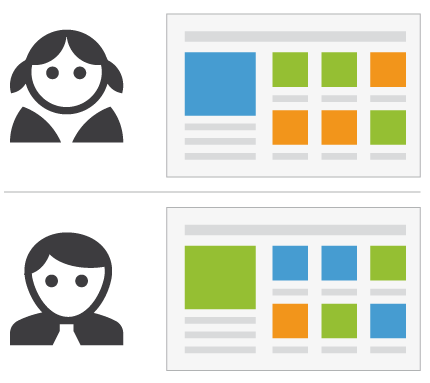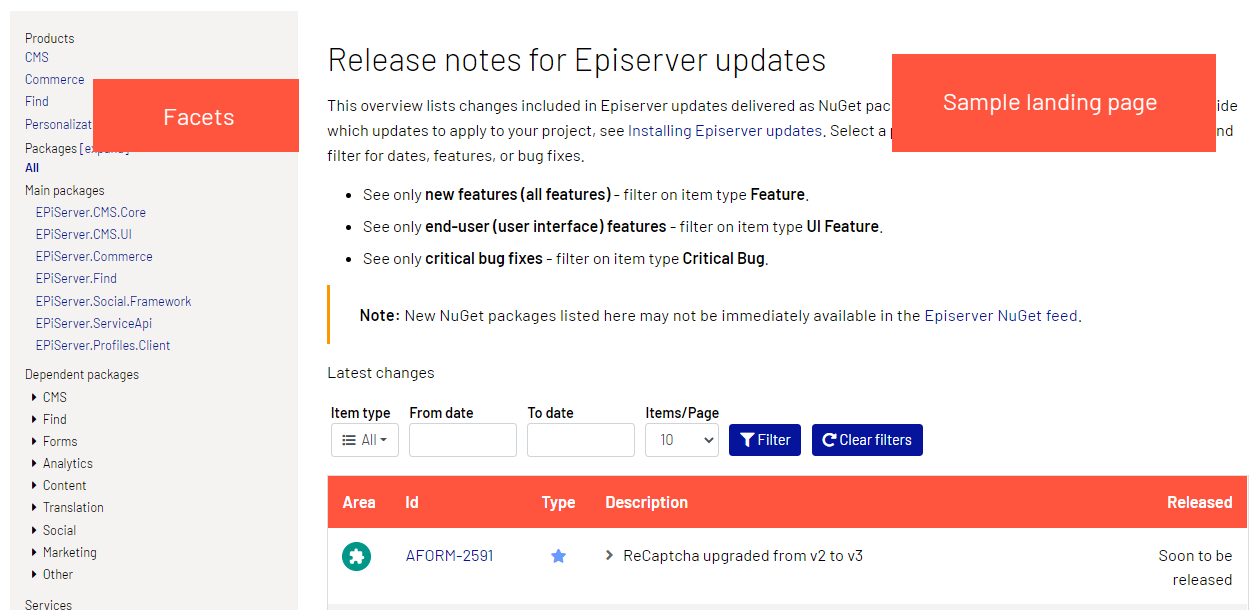 What is search optimization?
What is search optimization?
As a Web page's search rank increases, your website receives more visitors.

Optimizely Search & Navigation lets you develop customized functionality to create automatic landing pages and different types of adaptive navigation with minimal effort. While Optimizely Search & Navigation bases its SEO strategies on site visitor statistics, you can manually implement search optimization on targeted content to enhance the search experience.
Learn by doing
Most of Optimizely Search & Navigation's automatic SEO is based on queries made by site visitors. As the number of queries grows, Optimizely Search & Navigation "learns" and bases search suggestions on previous successful queries.
The new website
When developers set up a website and configure search, they use the programming interface to develop custom filters (along with built-in filters) and faceted search features. Because the site is new, search optimization has few statistics, so you can help visitors by adding search phrase One or more words that a user enters into a search box to begin a search. suggestions. See also: Autocomplete.
The growing website
As your website matures and accumulates search data, use search statistics to analyze search activity. Optimization evolves into monitoring, fine tuning, and promoting content to deliver the right content to visitors.
Automatic search optimization
You can attract visitors to your website and guide them to relevant content by coding the following features and tagging content properties.
Automatic landing pages
When you create a campaign, you usually make significant efforts to set up landing pages and display desired content in various places of the website. Tagging and search criteria let you create landing pages that dynamically display relevant content.

An automatic landing page (as in the example above) is actually a search page with a small editorial area at the top. Optimizely Search & Navigation drives search results through content tagging. Site visitors can narrow down search results using the facets.
Using Optimizely Search & Navigation, you can develop customized functionality to provide an SEO-friendly URL Stands for "Uniform Resource Locator". Also known as a web address such as http://world.optimizely.com. for the dynamic landing page, based on visitor-selected facets . Example: if you search for sweatshirt, the returned URL includes associated search facets, such as the following ../search/sweatshirt/women/hoodies.
Adaptive navigation
Website navigation often is static and based on a content structure that is well-known to editors but less intuitive to visitors. With search criteria, you can create navigation that displays personalized content based on what is known about the visitor, such as content relations or a registered profile.
Guided search
Optimizely Search & Navigation can suggest search phrases One or more words that a user enters into a search box to begin a search. automatically, based on the behavior of site visitors. Example: searching for page returns people searching for "page" also searched for "web page". The autocomplete feature also provides guided search.
Optimizing search manually
Although Optimizely Search & Navigation performs search optimization automatically, you should regularly monitor search activities on your website to fine-tune search performance and spot discrepancies. You may want override system suggestions to promote specific content.
Use the optimization view to perform manual search optimization. Optimization may also include modifying website content to achieve desired results. The following scenarios demonstrate how search optimization actions can guide visitors to appropriate content.
 Search phrase does not match wording in content
Search phrase does not match wording in content
Example: basket instead of cart. Help out by adding a synonym.
 Promote selected content
Promote selected content
Use best bets to promote selected pages' content. Example: if a visitor searches for Christmas cards, a Christmas special offer appears at the top of the search results.
 Visitors are not clicking search result links
Visitors are not clicking search result links
Low-click frequency may not be a problem—it can indicate that search results provide adequate information. But it also may indicate that the information is not attractive enough. Work with the content as described in this topic to ensure that an appropriate description appears in search results and SEO requirements are met. Or, create a best bet with a custom title and description.
 No search results returned because the content is missing
No search results returned because the content is missing
Use search statistics to discover if needed content is missing from your website. This requires a strong understanding of the content. Create the missing content and ensure it appears in search results.
 Content searched for is not on your website but visitors assume it is
Content searched for is not on your website but visitors assume it is
If visitors frequently search for content on a related website, add a connector to index that site's content and merge it with your site's search results.
 Returned results do not contain the search phrase
Returned results do not contain the search phrase
Add the search phrase to the content, or add synonyms, which let site visitors retrieve content without knowing exact wording.
 Relevant content is found but not displayed at the top
Relevant content is found but not displayed at the top
Work with the content to verify that SEO requirements are met. For example, make sure the page has a relevant title, correct and descriptive meta information, and an accurate modification date. Also, make sure the page has relevant keywords and search phrases. Use specific keywords instead of broad, widely-used terms. For example, agile commerce (instead of commerce) significantly narrows results.
See also general guidelines about optimizing content for search engines, such as Google's Search Engine Optimization Starter Guide.